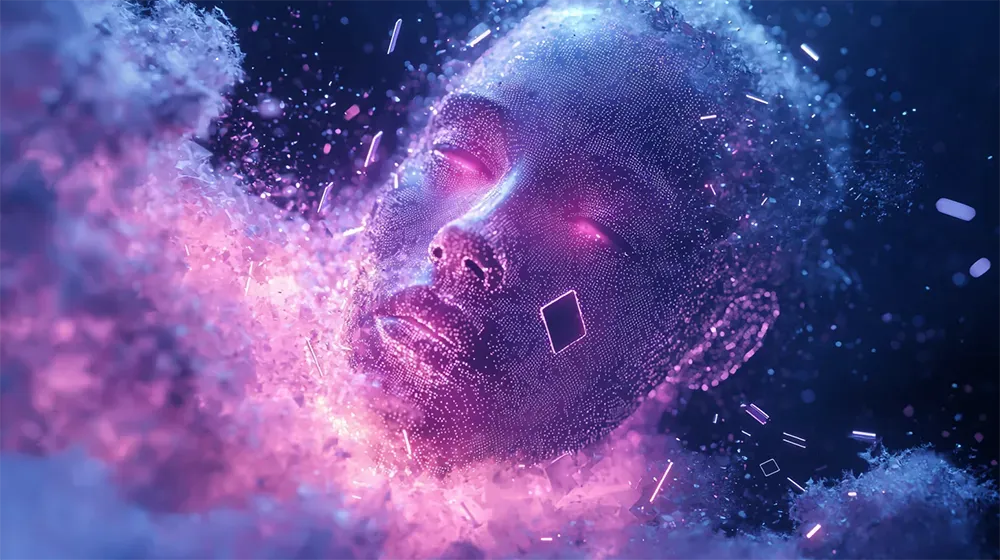Understanding Virtual Reality with the Help of a Futurist Speaker

Understanding Virtual Reality with the Help of a Futurist Speaker
Virtual reality (VR) is a transformative technology that has the potential to revolutionize various industries. However, for many people, understanding the intricacies of VR can be daunting. Luckily, there are futurist speakers who specialize in simplifying complex concepts and making them accessible to all. In this article, we will dive deep into the world of VR with the help of a futurist speaker, exploring the basics, the impact on different industries, the future trends, and the practical applications and opportunities for this exciting technology.
Understanding the Basics of Virtual Reality
Before we delve into the more complex aspects of virtual reality, let's first establish a solid foundation by understanding the basics. At its core, VR is a simulated experience that can be similar to or completely different from the real world. It typically involves the use of a headset that immerses the user in a three-dimensional computer-generated environment, allowing them to interact with and explore this virtual world.
One key component of VR is presence, which refers to the feeling of being physically present in the virtual environment. This is achieved through a combination of audio, visual, and often haptic feedback. By tricking our senses, VR can transport us to entirely new places and experiences, opening up a world of possibilities.
Imagine putting on a VR headset and suddenly finding yourself standing on the edge of a towering mountain peak. The crisp, cool air brushes against your face as you gaze out at the breathtaking panoramic view. You can hear the wind rustling through the trees and the distant sound of a waterfall cascading down into a crystal-clear lake. The sense of presence is so strong that you instinctively take a step back, fearing that you might actually fall off the edge.
As you explore this virtual world, you notice that you can interact with objects and manipulate the environment in ways that would be impossible in the real world. You reach out and touch a flower, feeling the delicate petals under your fingertips. You pick up a stone and toss it into the lake, watching the ripples spread out across the water's surface. The level of immersion is astonishing, as every action you take in the virtual world has a corresponding reaction.
But how does VR actually work? The headset you wear contains high-resolution displays that project stereoscopic images, creating the illusion of depth and dimension. These images are rendered in real-time by a powerful computer, which also tracks your head movements and adjusts the perspective accordingly. This tracking is crucial for maintaining the sense of presence, as it allows you to look around and explore the virtual environment from different angles.
In addition to visual feedback, VR often incorporates audio cues to enhance the immersive experience. With spatial audio technology, sounds are rendered in a way that mimics real-life, creating a sense of direction and distance. You can hear the footsteps of a character approaching from behind or the distant echo of a voice reverberating through a cavern. These subtle auditory details further contribute to the feeling of being fully immersed in the virtual world.
Another aspect of VR that adds to the sense of presence is haptic feedback. This technology allows you to feel physical sensations in the virtual world through the use of specialized controllers or haptic gloves. Imagine reaching out to touch a virtual object and feeling a gentle vibration in your hand as your fingers make contact. This tactile feedback adds an extra layer of realism and engagement, making the virtual experience even more convincing.
Virtual reality has come a long way since its inception, and its applications extend far beyond gaming and entertainment. Industries such as healthcare, education, architecture, and even space exploration are harnessing the power of VR to revolutionize their respective fields. From training medical professionals in realistic surgical simulations to allowing students to explore historical landmarks without leaving the classroom, the possibilities are endless.
So, the next time you put on a VR headset, remember that you are about to embark on a journey into a world where the boundaries of reality are blurred. With its ability to transport us to new places, evoke emotions, and create unforgettable experiences, virtual reality is truly a remarkable technological advancement.
How a Futurist Speaker Breaks Down Complex VR Concepts
Now that we have a grasp of the basics, let's explore how a futurist speaker can help us understand the more complex concepts of VR. These speakers are experts in their field, armed with in-depth knowledge and the ability to communicate complex ideas in a clear and engaging manner.
One of the key strategies employed by futurist speakers is the use of metaphors and real-world examples. They understand that abstract concepts can be difficult to grasp, especially for those who are new to the world of virtual reality. By drawing parallels between VR and familiar experiences, they make these concepts tangible and relatable.
For instance, when explaining the concept of "telepresence," a futurist speaker might compare it to video conferencing. They would highlight how VR can enhance remote collaboration by providing a more immersive and interactive experience. Instead of just seeing and hearing the other person on a screen, telepresence allows individuals to feel as if they are physically present in the same room, enabling more natural and engaging communication.
In addition to using metaphors, futurist speakers also delve into the technical aspects of VR. They understand that understanding the underlying technology is crucial to fully appreciating its potential. Therefore, they take the time to shed light on topics such as tracking systems, display resolutions, and input devices.
By unraveling the complexities of these technical aspects, futurist speakers empower their audience to better understand how VR works and what it can achieve. They explain how tracking systems, such as inside-out and outside-in tracking, enable the virtual world to synchronize with the user's movements, creating a seamless and immersive experience.
Moreover, they dive into the world of display resolutions, explaining the difference between lower-resolution and higher-resolution VR headsets. They emphasize how higher resolutions contribute to sharper and more realistic visuals, enhancing the overall immersion.
Furthermore, futurist speakers shed light on the various input devices used in VR, such as handheld controllers, haptic gloves, and even full-body tracking suits. They discuss how these devices enable users to interact with the virtual environment, whether it's grabbing objects, feeling tactile feedback, or even performing complex gestures.
Overall, futurist speakers play a crucial role in breaking down complex VR concepts. Through the use of metaphors, real-world examples, and a deep understanding of the technical aspects, they bridge the gap between the abstract and the concrete, making virtual reality more accessible and exciting for all.
The Impact of Virtual Reality on Various Industries
Virtual reality has the potential to revolutionize numerous industries, from gaming and entertainment to healthcare, education, and beyond. Let's explore some of the ways VR is already making an impact.
In the gaming industry, VR has unlocked a whole new level of immersion. Players can step into virtual worlds, interact with characters, and experience games in a way that was previously unimaginable. This technology has the power to transport us to fantastical realms, blurring the lines between reality and the virtual.
Imagine diving into a virtual ocean, surrounded by colorful coral reefs and exotic marine life. With VR, you can explore the depths of the ocean without leaving your living room. Swim alongside majestic whales, observe the intricate ecosystem of a coral reef, and discover the wonders of the underwater world.
But the impact of virtual reality extends far beyond gaming. In healthcare, VR is enabling groundbreaking advancements. Surgeons can now practice complex procedures in a virtual environment, reducing the risk to real patients. By simulating surgical scenarios, doctors can refine their skills, test new techniques, and improve patient outcomes.
Furthermore, virtual reality is proving to be a valuable tool in pain management and therapy. Patients suffering from anxiety or chronic pain can find relief through VR therapy. By immersing themselves in soothing environments, such as a tranquil forest or a serene beach, individuals can escape their physical discomfort and experience a sense of calm and relaxation.
For elderly individuals, virtual reality offers a way to revisit familiar places and memories, enhancing their well-being. Imagine an elderly person who is no longer able to travel due to physical limitations. With VR, they can virtually revisit their childhood home, walk through the streets of their favorite city, or attend a concert by their favorite musician. These experiences can evoke a sense of nostalgia and joy, improving their quality of life.
Education is another field where VR is making waves. Students can now explore historical events, travel to distant locations, and participate in immersive simulations to deepen their learning. Instead of reading about ancient civilizations in textbooks, students can step into the shoes of an archaeologist and uncover hidden treasures in a virtual excavation site. By providing a hands-on and interactive experience, VR has the potential to revolutionize the way we educate future generations.
Imagine a biology class where students can dissect virtual organisms, observe the inner workings of the human body, and witness the complexities of cellular processes in real-time. With VR, abstract concepts become tangible, and learning becomes an engaging adventure.
As virtual reality technology continues to evolve, its impact on various industries will only grow. From gaming and healthcare to education and beyond, VR has the potential to transform the way we experience the world and enhance our lives in countless ways.
A Futurist Speaker's Insight on Future Trends in VR
What does the future hold for virtual reality? A futurist speaker can offer invaluable insights into upcoming trends and developments. From advancements in hardware to the emergence of new applications, these speakers are at the forefront of predicting what's next.
One exciting trend is the convergence of VR with other technologies, such as augmented reality (AR) and artificial intelligence (AI). This fusion has the potential to create even more immersive and intelligent virtual experiences. Imagine a world where VR allows us to interact with lifelike AI avatars in a mixed reality setting, blurring the boundaries between the physical and digital worlds.
Furthermore, futurist speakers often highlight the democratization of VR, emphasizing how it is becoming more accessible and affordable. As VR technology continues to evolve, we can expect it to become a mainstream tool for communication, entertainment, and productivity.
Making the Most of Virtual Reality: Practical Applications and Opportunities
Now that we have explored the basics, the impact on various industries, and the future trends in VR, let's turn our attention to the practical applications and opportunities that virtual reality presents.
One area of opportunity lies in employee training. VR simulations can provide a safe and cost-effective way to train employees in various industries, from manufacturing and construction to customer service and emergency response. By immersing trainees in realistic scenarios, VR can enhance learning and retention, ultimately improving performance in the real world.
Virtual reality also holds immense potential in the realm of architecture and design. With VR, architects can create virtual walkthroughs of their designs, allowing clients to experience the space before it is built. This not only helps in visualizing the final result but also aids in identifying potential issues and making informed decisions early in the design process.
Another exciting opportunity lies in virtual tourism. With travel restrictions and environmental concerns, VR can offer a virtual escape to breathtaking destinations around the globe. Whether it's exploring the ancient ruins of Machu Picchu or diving into the vibrant coral reefs of the Great Barrier Reef, virtual tourism can transport us to places we may never have the chance to visit physically.
In conclusion, understanding virtual reality is essential in today's rapidly evolving digital landscape. With the help of a futurist speaker, we can unlock the mysteries of this transformative technology and explore its potential in various industries. From the basics to the future trends, virtual reality holds immense promise in revolutionizing the way we game, learn, heal, and interact with our world. So strap on your headset and let the journey into the virtual realm begin!
Frequently Asked Questions
1. What is virtual reality (VR) and how does it work?
Virtual reality is a simulated experience that can be similar to or completely different from the real world. It involves the use of a headset that immerses the user in a three-dimensional computer-generated environment. The headset contains high-resolution displays that project stereoscopic images, creating the illusion of depth and dimension. These images are rendered in real-time by a powerful computer, which also tracks the user's head movements and adjusts the perspective accordingly. VR often incorporates audio cues and haptic feedback to enhance the immersive experience.
2. How can a futurist speaker help in understanding virtual reality?
A futurist speaker specializes in simplifying complex concepts and making them accessible to all. They use metaphors, real-world examples, and technical explanations to break down the intricacies of virtual reality. By bridging the gap between the abstract and the concrete, futurist speakers make VR more understandable and exciting for everyone.
3. What are some practical applications of virtual reality?
Virtual reality has practical applications in various industries. In healthcare, it is used for surgical simulations, pain management, and therapy. In education, VR allows students to explore historical events and participate in immersive simulations. VR is also valuable in employee training, architecture and design, and virtual tourism. The possibilities for practical applications of VR are vast and continue to expand as the technology evolves.
Contact an Innovation Speaker for Your Event
If you're looking to bring a fresh and dynamic perspective to your next event, consider hiring Dr. Mark van Rijmenam, a leading futurist and innovation speaker. With his deep understanding of virtual reality and its impact on various industries, Dr. Mark can provide invaluable insights that will captivate and inspire your audience. By simplifying complex concepts and using relatable examples, he breaks down the intricacies of VR in a way that is accessible to all. Whether you're hosting a corporate conference, industry summit, or educational workshop, Dr. Mark's engaging and thought-provoking presentations will leave a lasting impact on your attendees.
When you contact Dr. Mark van Rijmenam, you can expect a prompt response. Our team understands the importance of timely communication, and we strive to provide exceptional customer service. Within 24 hours of reaching out, we will be in touch to discuss your event requirements and how Dr. Mark can tailor his presentation to meet your specific needs. Don't miss the opportunity to have a renowned futurist speaker elevate your event to new heights. Contact us today and let the journey into the future begin!
Thanks for your inquiry
We have sent you a copy of your request and we will be in touch within 24 hours on business days.
If you do not receive an email from us by then, please check your spam mailbox and whitelist email addresses from @thedigitalspeaker.com.
In the meantime, feel free to learn more about The Digital Speaker here.
Or read The Digital Speaker's latest articles here.





